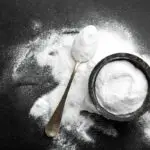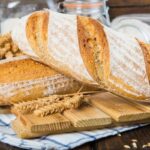If you’ve ever tried gluten-free baking, you’ve probably heard of xanthan gum.
Xanthan gum, a fundamental component in gluten-free baking, may assist you in getting tasty gluten-free baked products.
So, where do you begin? Keep reading this article to learn how to use xanthan gum in baking. From cakes to dough, gluten-free baking has never been easier.
Xanthan Gum: Definition
Do you know what xanthan gum is? Even professional bakers who are using xanthan gum in many recipes daily are unlikely to know what it comprises of.
However, reading about xanthan gum and what it accomplishes might assist you in better understanding how to incorporate it into your recipes.
So, let’s waste no time and learn about this special baking ingredient!
Xanthan gum is a popular cooking addition that is often included in recipes as a thickening and binding ingredient.
Condiments, salad dressings, desserts, and even kinds of toothpaste contain xanthan gum. Such items tend to stop oil breakdown and give our mouths a softer feeling.
Furthermore, its binding properties make it a great addition to gluten-free baked products such as cupcakes, brownies, and other pastries.
What Is The Purpose Of Xanthan Gum In Gluten-Free Baked Goods?
Apart from its many other applications, xanthan gum is commonly employed to manufacture gluten-free baked products that have a comparable smoothness to the regular ones.
If added in bakes, xanthan gum serves two functions:
- Xanthan gum, like gluten, aids in the binding of ingredients, resulting in better-structured baked products.
- Xanthan gum retains moisture, preventing baked items from drying out.
Most recipes (particularly those reliant on flour) struggle to keep their components together without gluten.
Consequently, these products turn out to be dry and can crumble just with a touch, as they cannot properly keep their shape without gluten.
Adding xanthan gum compensates for some of the elasticity lost due to the lack of gluten in GF foods by providing some of the elasticity.
By adhering to wheat and its humidity, xanthan gum replicates some of the most important features of gluten. This contributes to moistened baked foods that retain their form.
Using Xanthan Gum For Gluten-Free Baked Goods
Do you want to know how to utilize xanthan gum in your baking recipe?
Once you start baking, go through your gluten-free recipes, and read the ingredients list on the package of gluten-free flour you bought.
Should you choose flour made from nuts, such as almond flour, the single component will most likely be almonds.
However, should you get a pre-made gluten-free flour blend, it may already include xanthan gum, so you don’t have to add any extra.
Gluten-free flour blends are made from high-quality products such as sweet rice and brown rice flour, potato starch, sorghum flour, cassava flour, and xanthan gum to allow for 1-1 substitution in your recipe.
Flours like these ones work particularly great with recipes that ask for plain flour.
If the gluten-free flour you bought lacks xanthan gum, then you must separately include it in the recipe.
How Much Xanthan Gum Should I Put In A Recipe?
If you use xanthan gum, keep in mind that you only need a bit of it to have the greatest results.
If you decide to include xanthan gum in recipes that didn’t originally include it, we suggest using one-quarter of a teaspoon for every cup of flour. But this is only a rough approximation.
We recommend trying the recipes and tweaking them as required. If you don’t use much xanthan gum, your cake will be flaky and dry.
If you use more than needed, the dough/batter will turn out too gooey, making it difficult to blend and spread.
Xanthan Gum Removal
Having to clean up the mess while cooking with powdered dry ingredients like xanthan gum might be difficult.
Should you drop some xanthan gum on your countertop or floors, rather than soaking it, which would make it exceedingly slippery, use a cloth or sweeper to remove as much of the xanthan gum powder as possible.
Sensitivity To Xanthan Gum
Xanthan gum is a popular gluten-free cooking additive. Some, however, may experience some stomach discomfort with it.
If you experience stomach pain following the consumption of baked goods that included xanthan gum, the issue might be in the fact that you added too much of it in your recipe.
Otherwise, you are probably sensitive to it.
Among the most frequent xanthan gum intolerances are stomach swelling, stomachache, and general GI irritation.
Do not, however, despair if you find you have an intolerance to xanthan gum, as there are still other substitutes to make your gluten-free foods.
What To Do If You Can’t Seem To Find Xanthan Gum
If xanthan gum triggers gastrointestinal problems or you have run out of it and can’t pop into the shop to get some, you can use some other substitutes that will assist you in replicating gluten’s binding abilities.
The most common xanthan gum substitutes are chia seeds and flaxseeds.
If these seeds are soaked, they form a mucilaginous material that resembles the characteristics of xanthan gum.
The recipes you will be creating to make this alternative are basically chia seed and flaxseed egg.
When used for baked products, these ‘eggs’ help bind the components all together, giving the mixture shape and elasticity.
Leaving Out The Xanthan Gum
When you do not have any xanthan gum left, you might wonder what would happen if you ignored that recipe step.
When you do not have any xanthan gum left, you might wonder what would happen if you ignored that recipe step.
Although the result will differ in each recipe, typically, recipes that need xanthan gum to require it to retain form and puff.
Certain recipes, though, may be prepared effectively without xanthan gum by using a suitable volume of moisture with margarine, egg whites, and fat, even if the recipe asks for that too.
The only change you might detect is that your baked goods are slightly drier than usual.
The Bottom Line
Generally, xanthan gum is a multipurpose product that may be used in a variety of products ranging from desserts and milkshakes to pancakes and loaves of bread.
It binds even the driest flours and guarantees that your cooked or baked goods retain their moisture and structure during the cooking and baking process.
For coeliac or those sensitive to gluten, xanthan gum may turn gluten-free baking into a much easier task and allow you to recreate your favorite sweets without grains.










